|
|
|
Sort Order |
|
|
|
Items / Page
|
|
|
|
|
|
|
| Srl | Item |
| 1 |
ID:
078885
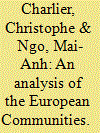

|
|
|
|
|
| Publication |
2007.
|
| Summary/Abstract |
The dispute European Communities-Protection of trademarks and geographical indications for agricultural products and foodstuffs, which opposes the European Union with the United States and Australia, has been raised by the European regulation concerning the protection of geographical indications (GIs). This dispute has two important issues. First, the Panel has demonstrated that the European Regulation does not comply with national treatment promulgated by the Agreement on Trade-Related Aspects of Intellectual Property Rights and the General Agreement on Tariffs and Trade 1994. Second, the Panel affirmed the possibility of some coexistence between GIs and identical prior trademarks. This article considers these issues and describes the positions of the parties at the end of the dispute over protection of GIs. The first part discusses the Panel's conclusions on national treatment and the coexistence of GIs and prior trademarks. The second part provides an analysis of the relationship between national treatment and international harmonization of the rules on the protection of GIs. This shows that if the Panel findings do not annihilate the European system of protection of GIs, the United States will find it advantageous to free ride and resist any move towards the European system of protection.
|
|
|
|
|
|
|
|
|
|
|
|
|
|
|
|
| 2 |
ID:
105119


|
|
|
|
|
| Publication |
2011.
|
| Summary/Abstract |
This article aims to evaluate the potential use of collective marks and geographical indications as forms of protection for ownership and differentiation of handicraft production in Brazil, considered as intangible heritage. Although, the instruments of intellectual property are, a priori, suitable only for products with industrial application, the above instruments of IPR could be applied to traditional crafts as well. Geographical indications and collective marks are forms of intellectual property protection that are associated with reputation protection and market distinctiveness. Apparently, they could be effectively used to protect and appropriate benefits of economic exploitation in the case of craftsmanship as in Brazilian artisan products
|
|
|
|
|
|
|
|
|
|
|
|
|
|
|
|
| 3 |
ID:
095006


|
|
|
|
|
| Publication |
2010.
|
| Summary/Abstract |
In debates in the World Trade Organization over the protection of geographical indications (GIs), the European Union (EU) has framed its position in terms of the potential for GIs to protect local cultures, offer a quality guarantee to consumers, and provide opportunities for value-added agriculture. A key tenet of the EU's argument is that GI schemes can be successfully implemented in developing countries as well as Europe. However, my analysis of the case of tequila shows that GIs in developing countries face unique challenges. Tequila is the oldest GI outside of Europe, and is often cited as an example of a successful GI in a developing country. Despite obvious successes in terms of its market share, however, the GI for tequila has largely failed to benefit the local population and environment. My examination of the tequila case illustrates how, throughout the history of the evolving GI legislation for tequila, influential actors have manipulated production standards in ways that contradict the theoretical concept of a GI and negatively affect the overall quality of tequila. I situate this case within the larger framework of international legislation on GIs, arguing that higher standards and a more context-specific approach are necessary.
|
|
|
|
|
|
|
|
|
|
|
|
|
|
|
|
| 4 |
ID:
095007
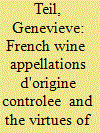

|
|
|
|
|
| Publication |
2010.
|
| Summary/Abstract |
There is something highly paradoxical about the French wine Appellations d'Origine Contrôlées (AOCs): the more they are considered to be suspect, the more they expand to other countries and products! Since their invention they have been suspected of not conveying reliable information. At the same time, supporters of quality wine have prayed for the development of a quality wine market and seen the suspicions concerning them as a threat that these actors have collectively tried to answer. But neither the accusation nor the defence has managed to close the debate. Accusation after accusation, the assessors acknowledgement of being able to define quality have changed, as has quality itself and the role given to AOCs. Far from sweeping away the old procedures, the new solutions have cohabited with them, transforming the wine market into a complex market hosting hundreds of thousands of brands and a variety of uses of quality signs by wine drinkers. Finally, contrary to most economists' fears, neither AOCs nor quality itself work by imposing themselves on the market actors. The greatest strength of AOCs may not be an ability to deceive consumers, but their capacity to raise doubts and to trigger considerable efforts by their defenders to quieten them.
|
|
|
|
|
|
|
|
|
|
|
|
|
|
|
|
| 5 |
ID:
095008
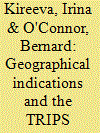

|
|
|
|
|
| Publication |
2010.
|
| Summary/Abstract |
The World Trade Organization (WTO) Agreement on Trade-Related Aspects of Intellectual Property Rights was the first multilateral international treaty (although not the first international treaty) to define and protect geographical indications (GIs) as a specific intellectual property type. There is some debate as to whether the agreement specifies the manner in which WTO members are to implement the protection or mandates a separate system for the protection of GIs (so-called "sui generis" protection). Rather than contributing further to this debate, this article provides a comprehensive overview of the means by which various WTO members have implemented the commitment to protect national and foreign GIs. In addition, the article looks at some examples of protected names in different jurisdictions and some of the problems encountered in registering GIs from outside the country effecting the protection.
|
|
|
|
|
|
|
|
|
|
|
|
|
|
|
|
| 6 |
ID:
178520
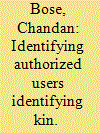

|
|
|
|
|
| Summary/Abstract |
The Geographical Indications of India Act requires a detailed description of ‘authorized users’ and ‘producers’ without concern for how these ‘producers’/ ‘authorized users’ are identified and what are the outcomes of such identification. Artisans identified as producers of GI registered ‘Cheriyal Painting’ of Telangana primarily belong to one genetically related family. Apart from members of the Danalakota household, GI also enumerates families of apprentices as ‘producers’. This article will highlight two things. First, it will demonstrate the way in which identification of ‘producers’/ ‘authorized users’ replicates not only the relational worlds within which producers exist but also the ‘obligations and moral imperatives’ embedded within those relations. Second, identifying oneself as a ‘producer’/ ‘authorized user’ requires distinguishing and individualizing one’s relatedness with the Danalakota family; promises of welfare by the state then become accessible only by becoming kin and distinguishing oneself as kin.
|
|
|
|
|
|
|
|
|
|
|
|
|
|
|
|
| 7 |
ID:
095011
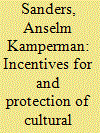

|
|
|
|
|
| Publication |
2010.
|
| Summary/Abstract |
After the adoption of the Universal Declaration of Cultural Diversity, the interaction between the protection of traditional cultural expressions (TCEs) and geographical indicators (GIs) is an interesting one. The capacity of a geographical indication of origin to create a global market with local control over brand, quality and methods of production seems to make it immensely suitable for preservation of cultural diversity. Since the Agreement on Trade-Related Aspects of Intellectual Property Rights does not limit the potential causes of action for the unauthorized use of GIs, the tort of misappropriation may be applied in relation to TCEs. In order to reconcile intellectual property rights with non-Western belief systems, application of the tort of misappropriation, unjust enrichment and the remedy of restitution may make enforcement of GIs in relation to TCEs more palatable than other forms of protection.
|
|
|
|
|
|
|
|
|
|
|
|
|
|
|
|
| 8 |
ID:
095009
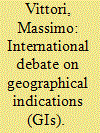

|
|
|
|
|
| Publication |
2010.
|
| Summary/Abstract |
Geographical indications (GIs) have progressively become a global phenomenon. The Agreement on Trade-Related Aspects of Intellectual Property has recognized GIs as a major category of intellectual property. Some 76 countries protect GIs today through specific legal systems (commonly referred to as sui generis), which provide for the registration of geographical names as a separate kind of intellectual property right. However, from the point of view of producers, several issues remain to be clarified in the international debate over GIs. First of all, the international rules do not provide the interested parties with effective legal remedies to stop infringements. As a result, unlawful uses of protected names have been increasing over the years. Monitoring GIs and reaching out to relevant enforcement authorities to denounce any eventual abuse are becoming complex and expensive tasks. Finally, in several countries, in spite of a tremendous potential, producers and policy-makers have not yet fully grasped the role of GI in terms of sustainable development. In light of the above, the purpose of this article is to provide an overview of the major issues characterizing the international debate over GIs and present the strategy adopted by the global coalition of GI producers-oriGIn-to address those problems.
|
|
|
|
|
|
|
|
|
|
|
|
|
|
|
|
| 9 |
ID:
094998
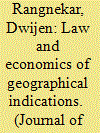

|
|
|
|
|
| Publication |
2010.
|
| Summary/Abstract |
After the adoption of the Universal Declaration of Cultural Diversity, the interaction between the protection of traditional cultural expressions (TCEs) and geographical indicators (GIs) is an interesting one. The capacity of a geographical indication of origin to create a global market with local control over brand, quality and methods of production seems to make it immensely suitable for preservation of cultural diversity. Since the Agreement on Trade-Related Aspects of Intellectual Property Rights does not limit the potential causes of action for the unauthorized use of GIs, the tort of misappropriation may be applied in relation to TCEs. In order to reconcile intellectual property rights with non-Western belief systems, application of the tort of misappropriation, unjust enrichment and the remedy of restitution may make enforcement of GIs in relation to TCEs more palatable than other forms of protection.
|
|
|
|
|
|
|
|
|
|
|
|
|
|
|
|
| 10 |
ID:
096424
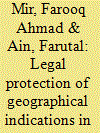

|
|
|
| 11 |
ID:
110488
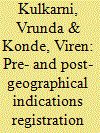

|
|
|
|
|
| Publication |
2011.
|
| Summary/Abstract |
Over the recent past, Geographical Indications (GIs) have emerged as a significant form of intellectual property rights in the Indian context. In view of the commercial potential of handicrafts, adequate legal protection of GIs becomes necessary to prevent their unauthorized utilization. The illegitimate practice of using geographical names not only damages the reputation of the original product, but also deprives the genuine right holders of the returns on investments for developing goods and its reputation in the market. Moreover, the consumers are likely to be misled into purchasing the counterfeits. This paper provides an overview of the current status of registered GIs and their classification with respect to handicrafts and their region-wise registrations. More importantly, this paper focuses on the need to improve the existing pre-and post-registration GI measures along with its reinforcement measures as critical factors to the success of the handicrafts industry in India.
|
|
|
|
|
|
|
|
|
|
|
|
|
|
|
|
| 12 |
ID:
095002
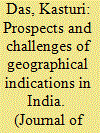

|
|
|
|
|
| Publication |
2010.
|
| Summary/Abstract |
In the recent past, geographical indications (GIs) have emerged as a significant intellectual property rights issue in the Indian context. Since 15 September 2003, when the Indian GI Act came into force, more than a hundred Indian products have been registered as GIs. However, there are several practical challenges confronting the stakeholders in India when it comes to the realization of the potential benefits ingrained in GIs. Apart from effective enforcement of the rights in the relevant markets (domestic and export), the success of a GI is contingent, in a large measure, upon appropriate marketing and promotion of the product-tasks that are not only resource-intensive but also challenging to execute for many stakeholders from a developing country like India. It is all the more tricky to ensure that a fair share of the benefits accruing from the GI status of a product reaches the actual producers/artisans downstream in the supply chain, unless an appropriate institutional mechanism is set in place towards that end. Against this backdrop, the article attempts to explore the prospects for India in exploiting the potential benefits embedded in GIs and the key challenges confronting the country in its endeavour to realize such benefits.
|
|
|
|
|
|
|
|
|
|
|
|
|
|
|
|
| 13 |
ID:
092461


|
|
|
|
|
| Publication |
2009.
|
| Summary/Abstract |
The protection of geographical indications for agricultural products and foodstuffs is one of the major pillars of the Common European Agricultural Policy and has become an important part of the transition from supporting commodity markets to enabling producers to market goods which satisfy consumer tastes. According to estimates, a total annual sales volume of approximately €14 bn is generated with protected geographical indications (PGI) and protected designations of origin (PDO). Nevertheless, the increase in utilization of the protection systems made obvious a number of problems in the practical application of the law. The Commission recognized these criticisms and announced a discussion on the regulation that was to commence officially in the autumn of 2008 with a Green Book about the PDO/PGI protection regime. In this context, the most recent problems are discussed and proposals are made that should be taken into account in order to accomplish the main goals of the regulation. Therefore this article is addressed to agricultural policy makers, consumer associations, as well as food producers and producer associations in Europe in order to provide a starting point for the Green Book debate.
|
|
|
|
|
|
|
|
|
|
|
|
|
|
|
|
| 14 |
ID:
095000
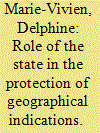

|
|
|
|
|
| Publication |
2010.
|
| Summary/Abstract |
Geographical indications (GIs) are remarkably different from other instruments of intellectual property rights (IPRs). Their acreage to the local provides an original scheme of governance. Contrary to other IPRs, GIs have only been homogenized in a very small way in the international legal framework. The issue is whether GIs are implemented as any other IPR, due to their collective and public dimensions. In particular, what is the role conferred to the state in the protection of GIs? The French legal framework, which largely influenced the European legal framework, is based on long traditions of protection of the appellations of origin and GIs where the role of the state has been declining, in order to give more responsibilities to the producer groups. The control task has been transferred from the state to the certification bodies to increase the guarantee of quality. The Indian experience, a post-TRIPS Agreement (the Agreement on Trade-Related Aspects of Intellectual Property Rights) example, shows a state and its agencies which are very active in the process of filing GI applications, including being themselves the applicant and eventually the proprietor. This might be justified by the lack of strong producer organization. These different roles of the state between France/Europe and India give a new understanding of the legal nature of GIs.
|
|
|
|
|
|
|
|
|
|
|
|
|
|
|
|
|
|
|
|
|